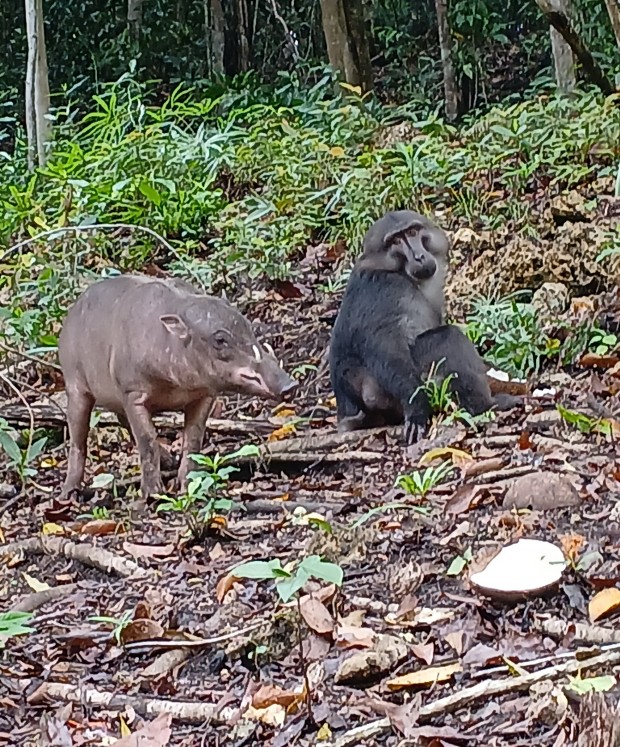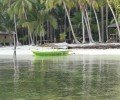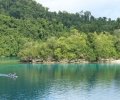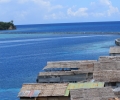Dr Ating Foundation: the departure of Coco, the arrival of Janey (Project update 2025)
Babirusa of Malenge Island
In the morning of May 21, 2025, I found Coco lying on the ground just two meters behind my morning meditation bench at the corner of the west cliff, where he sometimes slept on the dry grasses and leaves I had laid. He seems have chosen that spot as his last resting place because, probably, he knew I sat there near there every morning and would see his body. Or, he would, as a spirit, still able to see or hear us from that spot. What a smart creature! Coco has been with us since 2019 and well known locally—everybody in the island knows who Coco is—and internationally—hundreds photos and videos of his have been uploaded in the internet, including YouTube, and some articles or posting about him can be read online. He was the only tame wild babirusa in the world. But for Meidy and me, he is our sweet child that always bring joy and wonder to us. Thanks Coco for making us happy and farewell. Though not yet as sweet as Coco, Baru has replaced Coco in our life. He is younger than Coco, probably around seven years old, and has begun getting fame, started three days ago. Around 60 passengers of the cruise ship Heritage Adventure (belongs to the Heritage Expedition) from all five continents landed ashore on our bay and watched Baru eating coconuts, sweet potatoes, bananas, taros, and water cress Meidy provided in our yard. And everyone shot their cameras at him and Meidy, who sang a lullaby next to Baru to keep him stay as long as necessary. Three weeks before the owner of Taman Safari (Safari Garden) Indonesia from Jakarta and a wild pig specialist from Germany visited us. It was the mass death of babirusas caused by African Swine Flu on the mainland of Sulawesi last year that drove these important people to our remote home. They said that babirusa now is very difficult to find in the mainland, and they had heard about Coco and wanted to meet him. But they were late; Coco had passed away three days before. When we informed them about Baru, they decided to wait for him to show up, but were unlucky. Baru showed up just a few minutes after they left. Baru now has to share food from us with Neo, another male babirusa. Their age, color, and size about the same, which make us difficult to recognize one from the other. Only by seeing their pair of upper tusks we can distinguish them. Baru’s tusks merges at the tip while Neo’s are parallel. But we can also see the difference, for the time being, by looking at their movement: Baru stays calm when we approach him while Neo moves away quickly, though not far. This clue would be disappeared within two months because has been more habituated to us. The status of babirusas in the Red List of the IUCN, after their mass death last year, has to be reviewed. Population survey on the whole island of Sulawesi has to be carried out. The threatened level among three species might differ, but I am sure, all at least Endangered. And. though escaped from the African Swine Flu last year, the population of Togean babirusas still declines fast because of the on going trap and kill and the habitat loss in the islands of Batudaka, Togean and Talatako. On Malenge Island, these threats also exist but occur less after people knowing that Meidy and I protect babirusas, and babirusas are valuable to ecotourism. But real actions from the government and other concerned people or organizations are still needed because the limited resources we have now can only protect the babirusas around our home.
Janey and the Hanoman macaque troop
The orphan—that is the name Jane Goodall wrote in her email to me—has lived with us for two years. Her story started on June 11, 2023, the date Meidy and I remember very well. On that morning two little girls come to me when I was on the pier of Malenge village. “Doctor, Ibu Meidy called you,” one of the girls said. “Where is she?” “We will take you there.” I followed her on the only path in the village to the east and turned down to the coast after walking five hundred meters. And in front of a house I saw Meidy talk to some people. “Gyp, look at this!” I looked at it and was astounded. It was a baby of macaque on her bosom. Its head was bald; the scalp was reddish white, similar to its face; but the body had been covered with shiny black furs. What struck me most was her size; it was not bigger than one hand. Then Meidy told me briefly about her and some of the men filled out or clarified her story. According to them, about two weeks before a farmer saw a macaque troop raiding his coconut grove. His five dogs chased and attacked the troop. While the others ran away, the baby’s mother was left behind and killed by the dogs but he managed to save the baby who was still on her bosom. However, I don’t believe him—people here lie easily—he likely chopped the neck of the mother with his machete because the locals consider macaques are pests for stealing a few coconuts from their groves. He brought the baby home and gave it to his sister in-law, Mama Diana, who named her Pipih. Further inquiry, I suspect more than one macaque had been murdered because another baby had died in the village, someone tipped me off. We asked Mama Diana to give Pipih to us, explaining that we would return Pipih to her folks at our home. In the beginning she refused, but we managed to persuade her and then gave her 15 dollars for the milk she had bought for Pipih. Soon we hurried to our speedboat because I was afraid she would change her mind or ask for more money. It was a big event for us. We realize that we have taken a great responsibility and we don’t know how to take care a macaque baby properly. Janey, the new name for the baby, was cute. She was terrified on hearing the bark of Maya, our dog, at home. I guess she has PTSD (Post Traumatic Stress Disorder) after her mother attacked by the dogs. She urinates and even defecates whenever in fear. Thus, taking care of her isn’t easy, but we don’t mind. On the following day Mama Diana came. Janey recognized her voice and jumped to her bosom and kissed her cheek. It was amazing and touching to watch her behaviour but surprising when Mama Diana asked us to return Janey afterward. She grabbed her purse to give back the money insisting of having back Janey for the reason her daughter had kept crying. But we managed to keep Janey by persuasion and a gift of grass cutting machine given to the killer of Janey’s mother. The trouble continued in the next day. A team of the National Park Togean Islands came and warned us that keeping a macaque at home is a law violation because macaque is protected. But after we told them about the rescue of Janey and our plan to join her to the visiting troop of macaques in our home, they let us keep Janey. The visit of the NP team is a blessing in disguise. The family of the killer came again for Janey the day after but they left us after I told them that Janey had become the state child under our care until she joined the troop. The first two weeks were stressful for us. She was so fragile and emaciated from profuse diarrhea that I suspect caused by sweet condensed milk given in the village for about ten days. Lactose intolerance caused by cow milk. We ordered low-lactose milk from Ampana, which was found only in one shop, and her diarrhea stopped one week later. And she started eating banana and other fruit well. While input was not so difficult, the output was extremely hard. Macaque mother in the wild takes her baby on her bosom a full year and Janey was only about three weeks old then. Anytime we put her off our body, she screamed. So Meidy and I kept Janey stick to us 24-hour a day; she slept between us on our bed for more than a year, urinated and defecated on our clothes for about three months and on bed for one year. The most difficult problem is to prevent her from breaking anything apart in our house, library, and storage. We put everything in the latched boxes but she can open their lids—she can also open the zippers of bags—so that we have to secure them with masking tape. When Janey was nine months old, she was able to climb to the ceiling. It was the time the bulbs kept in the box, except one over the dining room. And we have to be alert with our expensive or important gadget or equipment. If we fail, Janey would grab and bite them—she had done this to one of glasses and a JBL mini speaker. No breakable things on any table or shelf because she love sweeping tables and shelves clean, pushing everything to the floor. We tried to train her not to do damage, but she is, though smarter than dogs, not trainable. She keeps doing non-sense whatever we say or do. In the end, after three months of resistance, Meidy had to agree with me that the only way to control the damage is to put her in a enclosure whenever she is indoor. That brings a moral obligation for me to take her, whenever the weather is good, to the Matahari Wildlife Sanctuary or the forest behind our bay every morning. Janey climbs trees happily there, and it relieves my guilt. The plan of joining her to the troop doesn’t work well. Janey only plays briefly with young macaques but back to us whenever the adult macaques nearby during the troop feeding on the Hanoman Hill, the east hill of our bay. We have to wait until her body produce sex hormone and she fells in love with one or more macaque boys. It is still two years more.
Wildlife Rescue
In addition to Janey, we also rescued two other animals in the last one year. I rescued a tarsier from the house of a illegal logger in Bangkagi village and released it in the forest next to our house after cutting the string on its waist. We named it Yoda and we still hear its call from our house during the full-moon night. The other animal was a Brahmini kite, a wonderful bird of prey, that was shot by an air rifle; the pellet broke its right wing. I wrapped it with the bandage of figure of 8 and she was disappeared after being able to walk normally. We assume or hope she survived. The detailed stories of these rescues will be filled in later.
Matahari Wildlife Sanctuary
As local people take everything that can be used, eaten or sold from the Matahari Wildlife Sanctuary, we decided to move there and rent our present house to tourists for covering our cost of living. In September 2024 I hired a carpenter to build our new house on the hill facing sea. From the porch, we can see sunset and the whole Matahari Beach bordered by the west mangrove, Over and behind is the the verdant hill of Malenge Island. If we walk a few meters to the east from our house, following the steep cliff, we watch the sunrise over another hill. It is my dream house. But it is still under construction.





